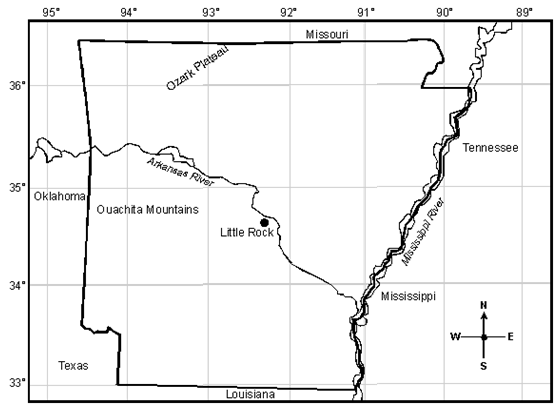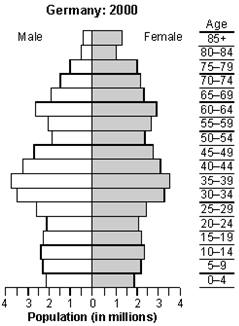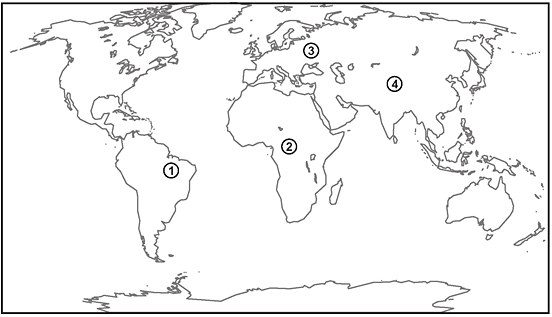Study Guide
Field 018: World History/Geography
Sample Selected-Response Questions
Recommendation for individuals using a screenreader: please set your punctuation settings to "most."
General Test Directions
This test consists of two sections: 1) a section with selected-response questions and 2) a constructed-response section.
Each question in the first section is a selected-response question with four answer choices. Read each question and answer choice carefully and choose the start uppercase ONE end uppercase best answer.
Try to answer all questions. Even if you are unsure of an answer, it is better to guess than not to answer a question at all. You will start uppercase NOT end uppercase be penalized for guessing.
The second section of this test consists of one constructed-response assignment. You will be asked to provide a written response to the assignment. Directions for completing your written response to the constructed-response assignment appear immediately before the assignment.
You may start uppercase NOT end uppercase use any type of calculator or reference materials during the test session.
Sample Selected-Response Questions
Competency 0001
Understand key historical terms, concepts, and major interpretations of world history,
and apply historical research skills.
1. start bold Read the passage below; then answer the question that follows. end bold
For over two thousand years, scholars have argued that the dynastic cycle has played a major role in the evolution of China. One major problem with this interpretive model is that it overestimates the influence of Chinese rulers by making the prosperity of China dependent on the virtue of its emperors when, during periods of both prosperity and decline, many of them were little more than figureheads. Another problem with the dynastic cycle as an organizing concept is its claim that China enters a period of decline whenever a dynasty collapses. That has not always been the case. For example, in the era between the fall of the Han dynasty and the founding of the Sui dynasty, Buddhism became a widely practiced religion in China. Rather than being a symptom of decline, the spread of Buddhism initiated an era of cultural innovation.
Which of the following responses best states the central argument of the passage?
- Use of the dynastic cycle as an interpretive model has obscured the importance of major cultural developments in Chinese history.
- Historians should not employ the dynastic cycle as an explanatory framework without first clarifying the actual achievements of successive Chinese emperors.
- Historians have come to realize that using the dynastic cycle as a framework for understanding Chinese history has several serious drawbacks.
- Uncritical use of the dynastic cycle as an explanatory model has created serious problems related to the periodization of Chinese history.
Correct Response: C. Given the stated shortcomings of the dynastic cycle as an interpretive model—i.e., its overestimation of the influence of rulers and its tendency to overlook important cultural advances that occurred during periods of purported decline—one can reasonably infer that the author believes scholars would do well to abandon the approach and develop a more suitable conceptual framework for understanding Chinese history.
Competency 0003
Understand the historical development of major Asian, African, and American civilizations.
2. Compared with the ancient civilizations created by the Mayas and Greeks, the ancient Romans and Aztecs were more likely to:
- adopt egalitarian practices that reduced distinctions among social classes.
- emphasize practical accomplishment over religious/philosophical practices.
- promote commercial expansion at the expense of agricultural development.
- distribute political power according to religious prophecies.
Correct Response: B. Whereas the Greeks and Mayas are remembered for their artistic and intellectual achievements, the Romans and Aztecs excelled in the areas of civic planning and the political management of vast empires. In this and related matters, Roman and Aztec culture tended to place great value on practicality, discipline, and force.
Competency 0004
Understand the development of world civilizations from the fall of the Roman Empire
through the Middle Ages.
3. In which of the following ways did the Islamic Empire of the eighth century CE differ most from previous empires of the Eastern Hemisphere?
- the cultural diversity of the peoples who belonged to the empire
- the complexity of the governmental bureaucracy established by Islamic rulers
- the strategic innovations of Islamic military leaders
- the size of major centers of Islamic economic and political life
Correct Response: A. The Islamic Empire of the eighth century CE stretched westward from India across North Africa into Europe's Iberian Peninsula and comprised an extraordinary diversity of cultures. One of the great strengths of Islamic rule during the period was its flexibility. Rather than impose their beliefs and values on conquered peoples, Muslim rulers permitted Christians, Jews, and other groups to continue the practice of their own religions and cultural traditions so long as their doing so did not threaten imperial authority.
Competency 0005
Understand the origins, events, and achievements of the Renaissance, the Reformation,
and the Scientific Revolution and their influence on the development of world civilization.
4. Compared with Catholic religious leaders of the Reformation era, Protestants of the period tended to place much greater emphasis on the:
- regular administration of the sacraments.
- use of ecclesiastical courts to maintain church discipline.
- importance of pastoral duties.
- effective delivery of scripture-based sermons.
Correct Response: D. In their reading of the Bible, Protestant reformers placed particular emphasis on Romans 10 colon 17, that "faith cometh by hearing, and hearing by the word of God." Given the importance that reformers attached to leading each worshipper to the truths contained in the Bible, ministers unable to deliver effective scripture-based sermons had no place in Protestant pulpits.
Competency 0008
Understand the major political, social, and economic developments of the nineteenth
century.
5. Which of the following statements best describes an important feature of the geography of early European industrialization?
- Industrialization proceeded most swiftly in regions with culturally diverse populations.
- Industrialization began earliest in regions that produced a diverse range of agricultural products.
- Industrialization proceeded most swiftly in regions with relatively high labor costs.
- Industrialization began earliest in regions that had clearly defined class structures.
Correct Response: C. The primary aim of the technological innovations that were at the heart of the Industrial Revolution was to increase output by having machines perform tasks previously done by hand. Thus, incentives for the introduction of such innovations, which enabled fewer people to produce ever-larger quantities of goods, were particularly great in regions with relatively high labor costs.
Competency 0009
Understand major historical developments of the first half of the twentieth century,
including the causes and consequences of the two world wars.
6. World War 2 facilitated the emergence of the Soviet Union as a superpower by:
- allowing the Soviets to play a leading role in the creation of the United Nations.
- eliminating opposition to Soviet expansion in the Middle East.
- destroying the authority of traditional leadership groups in Eastern Europe.
- enabling Stalin to complete his program for industrial development.
Correct Response: C. As a result of World War 2, traditional leadership groups throughout Eastern Europe suffered a serious loss of authority. Some did so because of wartime collaboration with Nazi occupiers; others were forced into exile. Taking advantage of the situation, the Soviet Union used its military strength to become the dominant power in the region.
Competency 0011
Understand how maps and other geographic tools are used to represent and analyze
the spatial organization of people, places, and environments on the earth's surface.
7. start bold Use the map of Arkansas below to answer the question that follows. end bold

The map shows the shape of the state of Arkansas with the longitude and latitude lines marked. Little Rock is shown near the center of the state, below the Arkansas River, which runs from west northwest to east southeast at about a 30 degree angle. The Ozark Plateau is labeled in the northwest portion of the state, and the Ouachita Mountains are labeled at the western edge of the state. The Mississippi River follows the east border of the state. The states that surround Arkansas are labeled, without lines to indicate the borders between them. The location of Little Rock with respect to the longitude and latitude lines is about halfway between 92 and 93 degrees west and about halfway between 34 and 35 degrees north.
According to the map shown above, the relative location of Little Rock, Arkansas, can best be described as:
- 34.5 degrees N longitude and 97.5 degrees W latitude
- in the middle of the state.
- approximately point 5 degrees south of 35 degrees N latitude and 2.5 degrees west of 90 degrees W longitude
- south of the Ozark Plateau and east of the Ouachita Mountains.
Correct Response: D. Geographers define the concept of relative location as the position of one place in relation to other places. Of the choices listed, D is the best response because it describes the location of Little Rock relative to more than one geographic feature using compass directions.
Competency 0012
Understand how to apply geographic data and use geographic tools to analyze geographic
problems and issues.
8. start bold Use the population pyramid below to answer the question that follows. end bold

The horizontal axis for the population pyramid is labeled "Population in millions" and has values labeled from 0 to 4 in increments of 0.5, extending to the left for male and to the right for female. The vertical axis is labeled "Age" and has values labeled from 0 to 85 plus in increments of 5, beginning with 0 to 4, 5 to 9, 10 to 14, through 80 to 84 and ending at 85 plus. The values are approximately symmetrical for male and female from age 0 to age 49, with values between 2 and 2.5 million from age 0 to age 29, values between 3 and 4 million from age 34 to age 44, and a value of about 2.5 million from age 45 to age 49. The values for males are less than those for females at ages above 49, with increasing differences in the values as they approach 85 plus, where the value for males is about 0.5 million and the value for females is about 1.25 million.
According to information presented in the population pyramid above, it is reasonable to conclude that by the year 2030, changes in Germany's dependency ratio will produce the greatest need for which of the following?
- constructing schools for the education of young children
- building leisure and recreational facilities for adolescents
- expanding employment opportunities for young adults
- providing health care and other social services for older citizens
Correct Response: D. In demography, the dependency ratio is the proportion of children and older citizens in a population that must be supported by people in their economically productive years. The population pyramid shows that Germany's dependency ratio will almost certainly rise as the proportion of the population aged 65 and older increases. To meet the needs of this growing older population, Germany will likely have to expand social services such as health care.
Competency 0015
Understand human systems and recognize the ways in which societies are organized
and how they interact with each other.
9. start bold Use the map below to answer the question that follows. end bold

The map shows the world in Mercator projection, with four regions labeled. Region 1 is slightly northeast of the center of South America. Region 2 is near the center of Africa. Region 3 is at the eastern edge of Europe. Region 4 is at the northern edge of the Indian subcontinent.
In which of the numbered regions on the map have climatic factors placed the greatest limits on population density?
- Region 1
- Region 2
- Region 3
- Region 4
Correct Response: D. The mountainous deserts of Region 4, with their long, extremely cold winters; limited precipitation; and short, unreliable growing seasons, place clear limitations on human activity as well as on plant and animal life.
Competency 0017
Understand the major physical and climatic features of Oklahoma, and use this knowledge
to examine the relationship between the physical environment and the historical
development of Oklahoma.
10. Which of the following best describes a major feature of Oklahoma's physical geography?
- Rainfall distribution in Oklahoma ranges from 30 inches a year in the southern half of the state to 70 inches a year in northern areas.
- Water flow in Oklahoma's rivers creates a northwest to southeast drainage pattern, though some streams move north or west before bending to the main pattern.
- As a result of periods of subzero weather in winter, Oklahoma's average annual temperature is about 45°F.
- Land elevation in Oklahoma ranges from 2,500 feet above sea level in the southeast corner of the state to 8,000 feet above sea level in the northwest corner.
Correct Response: B. In Oklahoma, elevation steadily drops from a height of nearly 5,000 feet above sea level in the northwest corner of the state to a low of 325 feet above sea level in the southeast corner. This causes water in the state's rivers to run from northwest to southeast except where scattered mountains and hills have created local variations in this drainage pattern.
